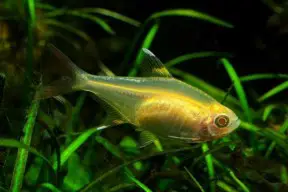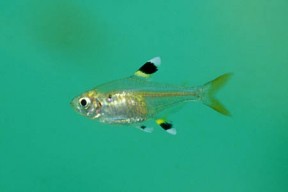Pristella maxillaris
X-ray Tetra
Classification
Order: Characiformes Family: Characidae
Distribution
Native to coastal waters of Venezuela, Guyana, Suriname, French Guiana and northern Brazil. You’re unlikely to see any wild fish for sale though. Due to its popularity it’s commercially bred in huge numbers for the trade. Most of the ones on sale in the UK originate from the Far East or Eastern Europe.
Habitat
During the dry season it inhabits clearwater streams and tributaries. When the rains come it moves into flooded areas of savannah, where it spawns amongst the submerged vegetation.
Maximum Standard Length
40 – 45 mm.
Aquarium SizeTop ↑
An aquarium with base dimensions of 60 ∗ 30 cm should be the smallest considered.
Maintenance
This mass-produced fish is adaptable and will do well in most tanks. It does look particularly effective in a heavily-planted arrangement though, and can appear a little washed out in very spartan setups.
If you really want to see it at its best, you could set up a biotope tank. Use a substrate of river sand and add a few driftwood branches (if you can’t find driftwood of the desired shape, common beech is safe to use if thoroughly dried and stripped of bark) and twisted roots. A few handfuls of dried leaves (again beech is a good choice. Oak leaves are also suitable) would complete the natural feel. Aquatic plants are not a feature of this species‘ natural waters. Allow the wood and leaves to stain the water the colour of weak tea, removing old leaves and replacing them every few weeks so they don’t rot and foul the water. A small net bag filled with aquarium-safe peat can be added to the filter to aid in the simulation of black water conditions. Fairly dim lighting should also be used. Under these conditions the true beauty of the fish will be revealed.
Water Conditions
Temperature: 22 – 28 °C
pH: 6.0 to 7.5
Hardness: As its natural waters are subject to annual flooding, the amount of dissolved minerals can fluctuate considerably over the course of the seasons. Hardness is thus not critical, and anywhere in the range 2 to 20°H is acceptable. However it breeds during the wet season when the water is naturally softer and more acidic, so a value towards the lower end of this range is best if you’re attempting to spawn it.
Diet
A micropredator, it feeds mainly on small invertebrates in nature. In the aquarium it proves unfussy. Feed a mixture of dried flakes and granules along with small live and frozen foods such as Daphnia or Artemia.
Behaviour and CompatibilityTop ↑
It’s a very peaceful species that won’t compete well with very boisterous or much larger tankmates. Ideally keep it with other South American species, such as other small tetras, pencil fish, hatchet fish, dwarf cichlids such as Apistogramma, Corydoras and small Loricariids.
In a more general community it can be combined with smaller rasboras, barbs, livebearers, loaches, Anabantoids and West African dwarf cichlids such as Pelvicachromis species.
Always buy a group of at least 6 of these, preferably 10 or more. It’s a shoaling species by nature, and will fare much better when in the company of its own kind. Like most tetras it actually looks far more effective when maintained like this anyway.
Sexual Dimorphism
Mature females are usually bigger and noticeably stockier than males
Reproduction
Easy enough to spawn, but raising the tiny fry can be quite tricky. You’ll need to set up a dedicated tank if you want to raise them in decent numbers. Something around 18″ x 10″ x 10″ in size is fine. This should be very dimly lit and contain clumps of fine-leaved plants such as java moss or spawning mops, to give the fish somewhere to deposit their eggs. Alternatively you could cover the base of the tank with some kind of mesh. This should be of a large enough grade so that the eggs can fall through it, but small enough so that the adults cannot reach them. The water should ideally be soft and acidic in the range pH 5.5-6.5, gH 1-5, with a temperature of around 80-84°F. Filtering the water through peat is useful, as is the use of RO water. A small air-powered sponge filter bubbling away very gently is all that is needed in terms of filtration.
It can be spawned in a group, with half a dozen specimens of each sex being a good number. Condition these with plenty of small live foods and spawning shouldn’t present too many problems. The adults can be removed once eggs can be seen, or in a very heavily planted tank left in situ and fry siphoned from the tank as they’re noticed.
In terms of productivity it’s best spawned in pairs. Under this technique the fish are conditioned in male and female groups in separate tanks, or via the use of a tank divider. When the females are noticeably full of eggs and the males are displaying their best colours, select the fattest female and best-coloured male and transfer them to the spawning tank in the evening. They should spawn the following morning. If no eggs have appeared after a couple of days remove them and try a different pair.
In either situation the adults will eat the eggs given the chance and should preferably be removed as soon as eggs are noticed. These will hatch in 24-36 hours, with the fry becoming free swimming a 3-4 days later. They should be fed on an infusoria–type food for the first few days, until they’re large enough to accept microworm or brine shrimp nauplii. Both eggs and fry are light sensitive in the early stages of life and the tank should be kept in darkness if possible.
NotesTop ↑
P. maxillaris is one of the more popular tetras in the hobby, and is easily obtainable from most aquatic shops. It must rank among the very best choices for the newcomer to fishkeeping as it’s peaceful, hardy and inexpensive. There’s a selectively-bred “golden” strain available which is actually a semi-albino fish. Care is much the same as for the standard form.
Currently the only species in the genus, in older literature it’s often referred to by the now invalid name Pristella riddlei. It’s also sometimes sold under different common names, including “pristella tetra” and “water goldfinch”.




November 17th, 2012 at 2:36 pm
Just want to add that I keep pristella for more than 3 years in a dedicated aquarium with a black background and dark substrate and the transparency in the fish is all but gone. They now exhibit a grayish body with a vivid red tail. The males seem to have a darker gray and more vivid colors than the females and also seem larger in lenght. I also believe that the minimum size for an aquarium should be 60*30cm as they can get very active at times. I keep mine with Neocaridina shrimps and they don’t eat the adults. Overall great fish, very peacefull, hardy and interesting to watch.
November 17th, 2012 at 3:15 pm
Hi Axel, thanks for the feedback, I’ve amended the tank size information. This is one of those species pages we haven’t got around to editing yet so there might be more dodgy info.
Cheers
March 26th, 2013 at 3:37 pm
I have 11 gold pristellas in a 75 gal community tank. Mine do not eat at the surface, but like to eat mid-tank or at the bottom. I set my filter on the lowest flow and release a pinch of food mid-tank. They are also more comfortable eating with the light off. I think this is a good way to make sure they get enough food. They are great fish.
November 11th, 2015 at 1:25 am
Hi, We have 5 of these guys and when we first got them they had a silver sheen over the belly like seen in pictures but now a couple of them are showing a redness (blood color). Otherwise they seem like they’re lively selves and are eating normal. Any ideas??
Thanks!